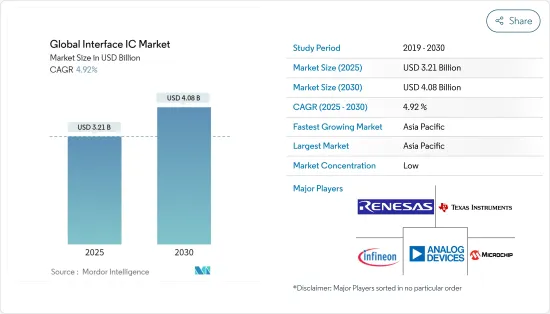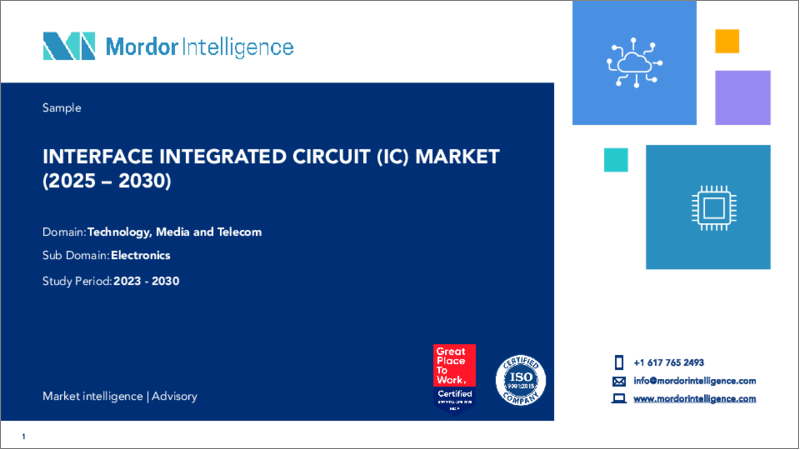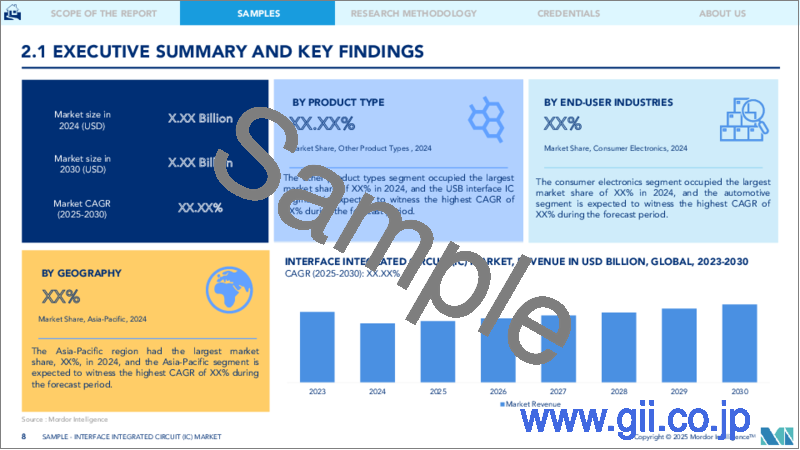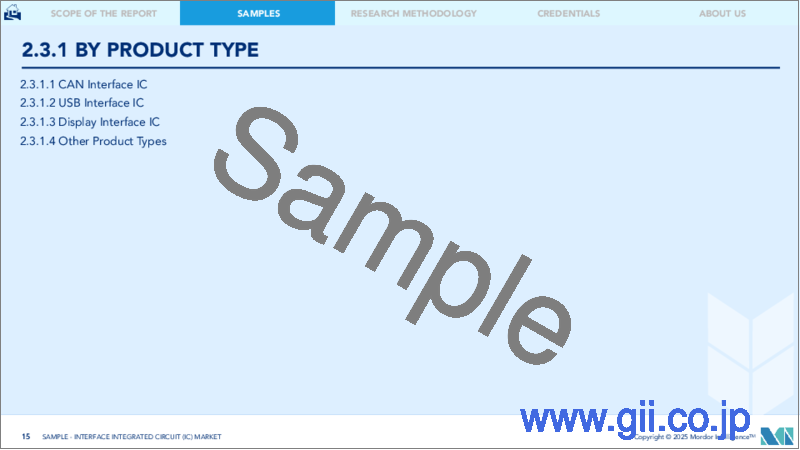|
|
市場調査レポート
商品コード
1644616
世界のインターフェースIC-市場シェア分析、産業動向と統計、成長予測(2025年~2030年)Global Interface IC - Market Share Analysis, Industry Trends & Statistics, Growth Forecasts (2025 - 2030) |
||||||
カスタマイズ可能
適宜更新あり
|
|||||||
| 世界のインターフェースIC-市場シェア分析、産業動向と統計、成長予測(2025年~2030年) |
|
出版日: 2025年01月05日
発行: Mordor Intelligence
ページ情報: 英文 122 Pages
納期: 2~3営業日
|
全表示
- 概要
- 目次
世界のインターフェースIC市場規模は、2025年に32億1,000万米ドルと推定され、予測期間(2025~2030年)のCAGRは4.92%で、2030年には40億8,000万米ドルに達すると予測されています。

インターフェースICは、電子インターフェース回路全体の機能を1チップに集約することで、デバイス間のコスト効率と信頼性の高い情報共有を実現します。多様な電子システム間の通信を管理・制御する機能を持つインターフェースICは、バイオメトリクス、電気自動車、通信に不可欠であり、電子回路基板におけるインターフェースICの需要に拍車をかけています。
主要ハイライト
- 集積回路(IC)インターフェースは、デバイス間の情報伝達を制御・促進する半導体チップです。電源電圧、データレート、動作電流、電力損失、温度ジャンクションなどの性能パラメータはすべて、ICインターフェースにとって重要な考慮事項です。これらのインターフェース集積回路(IC)は、異なる電子システム間の信号通信を管理する上で重要な役割を果たします。
- インターフェースICは、多様な電子部品やシステム間のシームレスな通信と効率的な連携を促進します。電子機器内のデータ、制御信号、電力のスムーズなやり取りを可能にすることで、これらのICは最適なパフォーマンスを保証します。USB、HDMI、イーサネット、SPI、I2C、CANなど、幅広い通信プロトコルや規格をサポートするよう特別に設計されています。
- インターフェースICに対する需要の増加は、主にコネクテッドデバイスの急増によってもたらされています。IoTエコシステムの急速な拡大に伴い、より多くのデバイスがシームレスな通信とデータ転送を必要とするようになり、インターフェースICはさまざまなコンポーネントやシステム間のデータ交換を容易にするために不可欠なものとなっています。その結果、民生用電子機器から産業用オートメーションまで幅広いセグメントでコネクテッドデバイスが増加し、これらの重要なチップに対する需要が高まっています。Ericssonによると、世界中のコネクテッドデバイスの総数は、2029年までに457億2,000万台に達すると予想されています。
- コンシューマー・エレクトロニクス市場は、革新的な製品と機能で進歩しています。スマートフォン、タブレット、ウェアラブル、スマートホームデバイスには、複数のセンサ、カメラ、接続オプションが搭載されるようになっており、これらのコンポーネントのシームレスな統合を可能にし、先進的機能を提供し、ユーザー体験を向上させるインターフェースICが必要とされています。
- 電子機器の複雑化に伴い、先進的システムオン・チップ(SoC)設計が行われるようになり、インターフェースICの統合には大きな課題があります。SoC内の性能、消費電力、スペース制約のバランスをとるには、インターフェースICの選択と配置を慎重に検討する必要があり、設計サイクルを複雑にし、開発コストを引き上げています。
インターフェースIC市場動向
エンドユーザーとして急成長する自動車産業
- 自動車セグメントの電気自動車やハイブリッド車市場は、著しい成長を遂げています。自動車技術と製造の進歩により、小型で電力効率の高いデバイスの需要も高まっています。
- ADAS(先進運転支援システム)の利用が増加し、ADASを義務付ける政府規制が世界中で実施されていることも、このセグメントの可能性を広げています。車載インフォテインメントの採用が増加していることも、成長機会をもたらすと考えられます。車載デジタル用途の継続的な進歩により、インターフェースICや技術の継続的な開発が必要となります。
- 自動車産業は、インターフェースICの重要なエンドユーザーのひとつです。自動車技術と製造の進歩により、コンパクトでエネルギー効率の高い電子機器へのニーズが高まっています。5Gネットワークの急速な拡大や、インテリジェントな輸送のための運転支援や車両間通信などのモノのインターネット(IoT)用途の人気の高まりは、インターフェースICの需要を増加させると予想されます。
- Synaptics Incorporatedは2023年1月、SmartBridge SB7900ローカルディミングICを発表し、コストと消費電力を抑えながら、より大型で高コントラスト、高解像度の車載LCDを可能にしました。SB7900 SmartBridgeは、最大30インチ、最大解像度6Kのディスプレイ向けに、画質の向上、システムの柔軟性の向上、デバイスの設置面積の削減、電力使用量の削減、複雑さの軽減を実現します。これは、複数のタッチとディスプレイドライバ統合(TDDI)コントローラを駆動する機能と、バックライト・アレイのローカル調光技術を統合することで実現されます。
- 地域全体で乗用車の生産台数が増加するにつれて、ADAS(先進運転支援システム)の採用が大幅に増加しています。この動向は、インターフェース集積回路(IC)の需要を促進すると予想されます。これらの部品は、さまざまなセンサ、プロセッサ、アクチュエータ間のシームレスな通信とデータ転送を保証するからです。
- これらのICは、カメラ、レーダー、LiDARセンサからの高速データを処理し、正確でタイムリーな情報処理を保証します。国際自動車工業会(OICA)によると、乗用車の生産台数は中国が261万2,376台で最大、次いで日本が77万6,543台となっています。
大きな成長を記録するアジア太平洋
- アジア太平洋には、TSMCやSamsung Electronicsのような産業リーダーを中心に、相当数の世界半導体製造施設があります。台湾、韓国、日本、中国を含むこの地域の主要国は、かなりの市場シェアを占めています。
- この地域は、半導体製造活動の量が多いため、市場のかなりの部分を占めると予想されています。WSTSによると、半導体売上高は、集積回路需要の高まりを背景に、2024年には前年比17.5%増、2025年には同12.3%増と顕著な伸びが予測されています。
- インド、中国、日本など、さまざまな国で民生用電子機器産業への投資が拡大していることが、インターフェース集積回路の需要拡大を大きく後押ししています。例えば、インドの民生用電子機器産業では大きな需要が見込まれています。「Make in India」や「Digital India」といったイニシアチブは、コンシューマーエレクトロニクス産業の拡大を促進しました。これらの戦略は、国内製造とデジタルインフラを強化することで、輸入への依存を減らし、インド国民にとって電子機器へのアクセスや購入しやすさを向上させることを目的としています。こうした取り組みが市場機会を押し上げると期待されています。
- IBEFの報告によると、インドは著名な製造拠点としての地位を確立しており、国内の電子機器生産額は2014-15年の290億米ドルから2022~23年には1,010億米ドルに増加します。最近、電子情報技術省はインドの電子機器製造に関するビジョン文書の第2巻を発表し、電子機器製造部門は2020~2021年の750億米ドルから2025~26年には3,000億米ドルに拡大すると予測しています。このような実質的な要因が市場の成長を促進すると予想されています。
- IBEFによると、インドのエレクトロニクス製造部門の成長を促進すると予想される主要製品には、携帯電話、ノートパソコンやタブレット端末などのITハードウェア、テレビやオーディオ機器などの民生用電子機器製品、産業用エレクトロニクス、ウェアラブルやウェアラブルなどがあります。
- Quess Corp.の調査報告によると、インドのエレクトロニクス産業では、2024年3月の全体的な雇用者数が前年同期比で154%増と顕著な伸びを示しました。Limitedの調査報告書によると、2024年3月の雇用者数は前年同期比で154%増加しました。同地域におけるこうした顕著な進歩は、エレクトロニクス産業全体のインターフェースIC需要を高めると予測されています。
- また、この地域のスマートフォンセグメントでの著しい開発も市場開拓の原動力になると予想されます。IBEFによると、インドは中国に次ぐ第2位の携帯電話製造国に浮上しました。過去10年間で、インドの携帯電話生産は20倍に増加し、493億米ドル(4兆1,000億インドルピー)に達しました。この目覚ましい成長は、主にPLI(Production Linked Incentive:生産連動奨励金)制度などの政府の取り組みによるものです。その結果、インドは国内の携帯電話需要の97%を賄えるようになり、巨大な市場機会を生み出すことになりました。
インターフェースIC産業概要
インターフェースIC市場は、世界参入企業と中小企業の両方が存在するため、非常にセグメント化されています。同市場の主要企業には、Infineon Technologies AG、Renesas Electronics Corporation、Texas Instruments Incorporated、Analog Devices Inc.、Microchip Technology Inc.などがあります。市場参入企業は、製品ラインナップを強化し、サステイナブル競争優位性を獲得するために、提携や買収などの戦略を採用しています。
- 2024年7月-半導体の世界的参入企業であるAnalog Devices Inc.は、バイオプラットフォーム・イノベーションのパイオニアであるFlagship Pioneeringと提携し、完全にデジタル化された生物学的領域の進化を加速します。アナログとデジタル半導体エンジニアリングにおけるADIの卓越した技術と、Flagship Pioneeringの応用生物学の専門知識を融合させることで、このコラボレーションは、生物学的洞察の深化、測定の精緻化、診断の強化、革新的な介入の導入を目指します。
- 2024年4月-Microchip TechnologyはNeuronix AI Labsを買収し、フィールドプログラマブルゲートアレイ(FPGA)での電力効率に優れたAI主導のエッジソリューションを強化しました。Neuronix AI Labsはニューラルネットワークのスパース最適化を専門としており、画像分類、物体検出、セマンティックセグメンテーションなどのタスクにおいて、高い精度を確保しながら消費電力、サイズ、計算量の削減を可能にします。
その他の特典
- エクセル形式の市場予測(ME)シート
- 3ヶ月間のアナリストサポート
目次
第1章 イントロダクション
- 調査の前提条件と市場定義
- 調査範囲
第2章 調査手法
第3章 エグゼクティブサマリー
第4章 市場洞察
- 市場概要
- 産業の魅力-ポーターのファイブフォース分析
- 供給企業の交渉力
- 買い手の交渉力
- 新規参入業者の脅威
- 代替品の脅威
- 競争企業間の敵対関係
- COVID-19とマクロ経済動向の市場への影響分析
第5章 市場力学
- 市場促進要因
- コネクテッドデバイスと通信技術の利用増加
- スマートフォン、タブレット、ウェアラブルなどのコンシューマーエレクトロニクスに対する需要の増加が市場の需要を牽引
- 市場抑制要因
- 設計の複雑さと製造プロセスにおける統合の課題
第6章 市場セグメンテーション
- 製品タイプ別
- CANインターフェースIC
- USBインターフェースIC
- ディスプレイインターフェースIC
- その他
- エンドユーザー産業別
- 民生用電子機器
- 電気通信
- 産業用
- 自動車
- その他
- 地域別
- 北米
- 欧州
- アジア
- オーストラリア・ニュージーランド
- ラテンアメリカ
- 中東・アフリカ
第7章 競合情勢
- 企業プロファイル
- Infineon Technologies AG
- Renesas Electronics Corporation
- Texas Instruments Incorporated
- Analog Devices, Inc.
- Microchip Technology Inc
- NXP Semiconductors Nv
- Broadcom Inc.
- SEIKO Epson Corporation
- Toshiba Corporation
- ON Semiconductor Corporation
第8章 投資分析
第9章 将来展望
The Global Interface IC Market size is estimated at USD 3.21 billion in 2025, and is expected to reach USD 4.08 billion by 2030, at a CAGR of 4.92% during the forecast period (2025-2030).

Interface ICs consolidate entire electronic interface circuit functions onto a single chip, ensuring cost-effective and reliable information sharing between devices. Their capability to manage and control communications across diverse electronic systems makes them integral to biometrics, electric vehicles, and telecommunications, fueling the demand for interface ICs in electronic circuit boards.
Key Highlights
- Integrated circuit (IC) interfaces are semiconductor chips that regulate and facilitate the transfer of information between devices. Performance parameters such as supply voltage, data rate, operational current, power dissipation, and temperature junction are all important considerations for IC interfaces. These interface-integrated circuits (ICs) play a crucial role in managing signal communications between different electronic systems.
- Interface ICs facilitate seamless communication and efficient collaboration among diverse electronic components and systems. By enabling the smooth exchange of data, control signals, and power within electronic devices, these ICs ensure optimal performance. They are specially designed to support a wide range of communication protocols and standards, including USB, HDMI, Ethernet, SPI, I2C, and CAN.
- The increasing demand for interface ICs is primarily driven by the proliferation of connected devices. As the IoT ecosystem rapidly expands, more devices require seamless communication and data transfer, where interface ICs are essential for facilitating this data exchange among various components and systems. Consequently, as sectors ranging from consumer electronics to industrial automation experience a rise in connected devices, the demand for these critical chips intensifies. According to Ericsson, the total number of connected devices across the globe is expected to reach 45.72 billion by 2029.
- The consumer electronics market is advancing with innovative products and features. Smartphones, tablets, wearables, and smart home devices are now being incorporated with multiple sensors, cameras, and connectivity options, requiring interface ICs as they enable the seamless integration of these components, providing advanced functionalities and enhancing user experiences.
- The increasing complexities of electronic devices have led to sophisticated system-on-chip (SoC) designs, presenting significant challenges for interface IC integration. Balancing performance, power consumption, and space constraints within the SoC requires careful consideration of interface IC selection and placement, complicating design cycles and raising development costs.
Interface IC Market Trends
Automotive Industry to be the Fastest Growing End User
- The market for electric and hybrid vehicles in the automotive sector is experiencing significant growth. The advancements in automotive technology and manufacturing are also increasing the demand for compact, power-efficient devices.
- The increasing usage of advanced driver-assistance systems (ADAS) and the implementation of government regulations worldwide that require ADAS are also broadening the potential of this sector. The rising adoption of vehicle infotainment will offer growth opportunities. The ongoing advancements in automotive digital applications necessitate the continual development of interface IC and technologies.
- The automotive sector is one of the significant end users of interface IC. The advancements in automotive technology and manufacturing are increasing the need for compact, energy-efficient electronics. The swift expansion of 5G networks and the rising popularity of Internet of Things (IoT) applications like assisted driving and vehicle-to-everything communication for intelligent transportation are expected to increase demand for interface ICs.
- Synaptics Incorporated introduced the SmartBridge SB7900 local dimming IC in January 2023, enabling larger, higher-contrast, higher-resolution car LCDs at a reduced cost and power consumption. The SB7900 SmartBridge offers improved image quality, increased system flexibility, decreased device footprint, power usage, and complexity for displays up to 30 inches and resolutions up to 6K. This is achieved by integrating the capability to drive multiple touch and display driver-integrated (TDDI) controllers with local dimming technology for the backlight array.
- With the increasing production of passenger cars across the region, the adoption of Advanced Driver Assistance Systems (ADAS) has risen significantly. This trend is expected to drive the demand for interface integrated circuits (ICs), as these components ensure seamless communication and data transfer among various sensors, processors, and actuators.
- These ICs handle high-speed data from cameras, radars, and LiDAR sensors, ensuring accurate and timely information processing. According to the International Organization of Motor Vehicle Manufacturers (OICA), China was the largest producer of passenger cars with 26,123.76 units, followed by Japan with 7,765.43 units.
Asia-Pacific to Register Major Growth
- The Asia-Pacific region is home to a considerable number of global semiconductor manufacturing facilities, prominently featuring industry leaders such as TSMC and Samsung Electronics. Key nations within this region, including Taiwan, South Korea, Japan, and China, possess substantial market shares.
- The region is anticipated to capture a significant portion of the market due to a high volume of semiconductor manufacturing activities. According to WSTS, a remarkable increase in semiconductor sales is projected, with a year-on-year growth of 17.5% in 2024 and 12.3% in 2025, driven by the rising demand for integrated circuits.
- The growing investments in the consumer electronics industry across various countries like India, China, Japan, and others are significantly driving the growth of the demand for interface integrated circuits. For instance, the market is expected to witness a significant demand across India's consumer electronics industry. Initiatives such as "Make in India" and "Digital India" have catalyzed expansion within the consumer electronics industry. These strategies are designed to enhance domestic manufacturing and digital infrastructure, thereby decreasing reliance on imports and increasing the accessibility and affordability of electronics for the Indian population. Such initiatives are expected to boost the market opportunities.
- As reported by IBEF, India has established itself as a prominent manufacturing center, with its domestic electronics production increasing from USD 29 billion in 2014-15 to USD 101 billion in 2022-23. Recently, the Ministry of Electronics & Information Technology published the second volume of the Vision document on Electronics Manufacturing in India, which projects that the electronics manufacturing sector will expand from USD 75 billion in 2020-21 to USD 300 billion by 2025-26. These substantial factors are anticipated to enhance the growth of the market.
- According to IBEF, the primary products anticipated to propel growth in India's electronics manufacturing sector include mobile phones, IT hardware such as laptops and tablets, consumer electronics like televisions and audio devices, industrial electronics, as well as wearables and wearables, among others.
- The electronics industry in India has experienced a remarkable 154% increase in overall hiring in March 2024 compared to the same period last year, as reported by research from Quess Corp. Limited. These notable advancements in the region are projected to enhance the demand for interface ICs throughout the electronics industry.
- The region's significant developments in the smartphone segment are also expected to drive market opportunities. IBEF stated that India has emerged as the second-largest mobile phone manufacturing nation, following China. Over the past decade, mobile phone production in India has increased twenty-onefold, achieving a value of USD 49.3 billion (INR 4.1 lakh crore). This remarkable growth can be attributed primarily to government initiatives, including the Production Linked Incentive (PLI) scheme. As a result, India is now capable of fulfilling 97% of its domestic mobile phone demand, which will create enormous market opportunities.
Interface IC Industry Overview
The interface IC market is highly fragmented due to the presence of both global players and small and medium-sized enterprises. Some of the major players in the market are Infineon Technologies AG, Renesas Electronics Corporation, Texas Instruments Incorporated, Analog Devices Inc., and Microchip Technology Inc. Players in the market are adopting strategies such as partnerships and acquisitions to enhance their product offerings and gain sustainable competitive advantage.
- July 2024 - Analog Devices Inc., a global player in semiconductors, teamed up with Flagship Pioneering, a pioneer in bio-platform innovations, to fast-track the evolution of a fully digitized biological realm. By merging ADI's prowess in analog and digital semiconductor engineering with Flagship Pioneering's applied biology expertise, the collaboration aims to unveil deeper biological insights, refine measurements, enhance diagnostics, and introduce innovative interventions.
- April 2024 - Microchip Technology acquired Neuronix AI Labs, enhancing its power-efficient, AI-driven edge solutions on field programmable gate arrays (FPGAs). Neuronix AI Labs specializes in neural network sparsity optimization, allowing for reduced power consumption, size, and computational needs in tasks like image classification, object detection, and semantic segmentation, all while ensuring high accuracy.
Additional Benefits:
- The market estimate (ME) sheet in Excel format
- 3 months of analyst support
TABLE OF CONTENTS
1 INTRODUCTION
- 1.1 Study Assumptions and Market Definition
- 1.2 Scope of the Study
2 RESEARCH METHODOLOGY
3 EXECUTIVE SUMMARY
4 MARKET INSIGHTS
- 4.1 Market Overview
- 4.2 Industry Attractiveness - Porter's Five Forces Analysis
- 4.2.1 Bargaining Power of Suppliers
- 4.2.2 Bargaining Power of Buyers
- 4.2.3 Threat of New Entrants
- 4.2.4 Threat of Substitutes
- 4.2.5 Intensity of Competitive Rivalry
- 4.3 Impact Analysis of COVID-19 and Macroeconomic Trends on the Market
5 MARKET DYNAMICS
- 5.1 Market Drivers
- 5.1.1 Rising Usage of Connected Devices and Communication Technologies
- 5.1.2 Increasing Demand for Consumer Electronics Such as Smartphones, Tablets, and Wearables, Driving Demand in the Market
- 5.2 Market Restraints
- 5.2.1 Complexity in Design and Integration Challenges in the Manufacturing Process
6 MARKET SEGMENTATION
- 6.1 By Product Type
- 6.1.1 CAN Interface IC
- 6.1.2 USB Interface IC
- 6.1.3 Display Interface IC
- 6.1.4 Other Product Types
- 6.2 By End-user Industry
- 6.2.1 Consumer Electronics
- 6.2.2 Telecom
- 6.2.3 Industrial
- 6.2.4 Automotive
- 6.2.5 Other End-user Industries
- 6.3 By Geography
- 6.3.1 North America
- 6.3.2 Europe
- 6.3.3 Asia
- 6.3.4 Australia and New Zealand
- 6.3.5 Latin America
- 6.3.6 Middle East and Africa
7 COMPETITIVE LANDSCAPE
- 7.1 Company Profiles
- 7.1.1 Infineon Technologies AG
- 7.1.2 Renesas Electronics Corporation
- 7.1.3 Texas Instruments Incorporated
- 7.1.4 Analog Devices, Inc.
- 7.1.5 Microchip Technology Inc
- 7.1.6 NXP Semiconductors Nv
- 7.1.7 Broadcom Inc.
- 7.1.8 SEIKO Epson Corporation
- 7.1.9 Toshiba Corporation
- 7.1.10 ON Semiconductor Corporation





